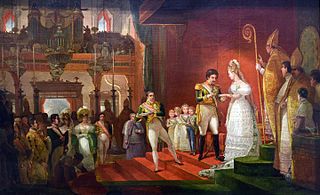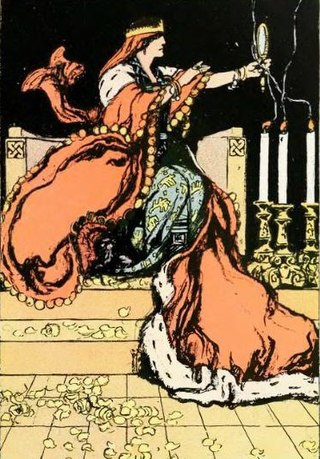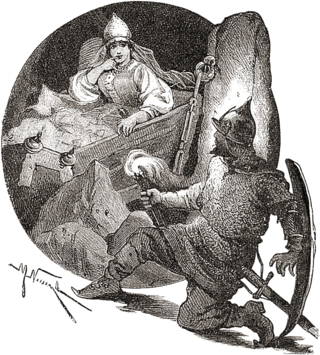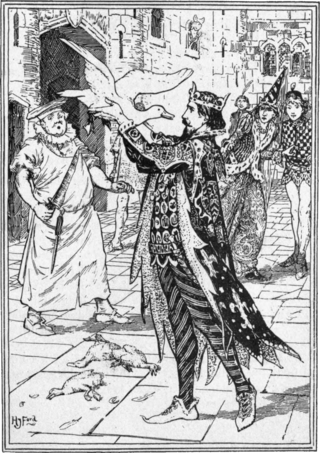
"Cinderella", or "The Little Glass Slipper", is a folk tale with thousands of variants that are told throughout the world. The protagonist is a young girl living in forsaken circumstances who is suddenly blessed by remarkable fortune, with her ascension to the throne via marriage. The story of Rhodopis, recounted by the Greek geographer Strabo sometime between 7 BC and AD 23, about a Greek slave girl who marries the king of Egypt, is usually considered to be the earliest known variant of the Cinderella story.

"Snow White" is a German fairy tale, first written down in the early 19th century. The Brothers Grimm published it in 1812 in the first edition of their collection Grimms' Fairy Tales, numbered as Tale 53. The original German title was Sneewittchen; the modern spelling is Schneewittchen. The Grimms completed their final revision of the story in 1854, which can be found in the 1857 version of Grimms' Fairy Tales.

A stepmother, stepmum or stepmom is a female non-biological parent married to one's preexisting parent. Children from her spouse's previous unions are known as her stepchildren. A stepmother-in-law is a stepmother of one's spouse.

In mythology, folklore and speculative fiction, shapeshifting is the ability to physically transform oneself through unnatural means. The idea of shapeshifting is found in the oldest forms of totemism and shamanism, as well as the oldest existent literature and epic poems such as the Epic of Gilgamesh and the Iliad. The concept remains a common literary device in modern fantasy, children's literature and popular culture. Examples of shapeshifters are vampires and werewolves.

"Hansel and Gretel" is a German fairy tale collected by the Brothers Grimm and published in 1812 as part of Grimms' Fairy Tales.

The Evil Queen, also called the Wicked Queen or the Queen, is a fictional character and the main antagonist of "Snow White," a German fairy tale recorded by the Brothers Grimm. The most popular version of the Evil Queen is in Disney's Snow White. The character has also become an archetype that has inspired unrelated works.
"Snow, Glass, Apples" is a 1994 short story written by Neil Gaiman. It was originally released as a benefit book for the Comic Book Legal Defense Fund and was reprinted in the anthology Love in Vein II, edited by Poppy Z. Brite. It is a retelling of the Brothers Grimm fairy tale Snow White, but from her stepmother's point of view.

"Brother and Sister" is a European fairy tale which was, among others, written down by the Brothers Grimm. It is a tale of Aarne–Thompson Type 450. In Russia the story was more commonly known as "Sister Alionushka, Brother Ivanushka", and collected by Alexander Afanasyev in his Narodnye russkie skazki.

The Tale of the Dead Princess and the Seven Knights is an 1833 poem by Aleksandr Pushkin telling a fairy tale of Prince Yelisei's search for his love, the Tsarevna (princess), who has been cast out by her stepmother.

The Wonderful Birch is a Finnish/Russian fairy tale. A variant on Cinderella, it is Aarne–Thompson folktale type 510A, the persecuted heroine. It makes use of shapeshifting motifs. Andrew Lang included it in The Red Fairy Book.

"The Three Little Men in the Wood" or "The Three Little Gnomes in the Forest" is a German fairy tale collected in 1812 by the Brothers Grimm in Grimm's Fairy Tales. Andrew Lang included it in The Red Fairy Book (1890) as "The Three Dwarfs," and a version of the tale appears in A Book of Dwarfs (1964) by Ruth Manning-Sanders.

Bushy Bride is a Norwegian fairy tale collected by Asbjørnsen and Moe. It is Aarne-Thompson type 403. It is included in Andrew Lang's Red Fairy Book.

The White Duck is a Russian fairy tale collected by Alexander Afanasyev in Narodnye russkie skazki. Andrew Lang included it in The Yellow Fairy Book.
The Two Caskets is a Scandinavian fairy tale included by Benjamin Thorpe in his Yule-Tide Stories: A Collection of Scandinavian and North German Popular Tales and Traditions. Andrew Lang included it in The Orange Fairy Book.
The Enchanted Wreath is a Scandinavian fairy tale, collected in Benjamin Thorpe in his Yule-Tide Stories: A Collection of Scandinavian and North German Popular Tales and Traditions. Andrew Lang adapted a variant of it for The Orange Fairy Book.
Maiden Bright-eye is a Danish fairy tale, that Andrew Lang included it in The Pink Fairy Book. It is ATU 403 The White Bride and the Black Bride.
Biancabella and the Snake is an Italian literary fairy tale written by Giovanni Francesco Straparola in The Facetious Nights of Straparola.
"The True Bride" or "The True Sweetheart" is a German fairy tale collected by the Brothers Grimm in Grimm's Fairy Tales as tale 186.

"The Two Kings' Children" is a German fairy tale collected by the Brothers Grimm in Grimm's Fairy Tales, tale number 113.

King Lindworm or Prince Lindworm is a Danish fairy tale published in the 19th century by Danish folklorist Svend Grundtvig. The tale is part of the more general cycle of the Animal as Bridegroom, and is classified in the Aarne–Thompson–Uther Index as tale type ATU 433B, a type that deals with maidens disenchanting serpentine husbands.













